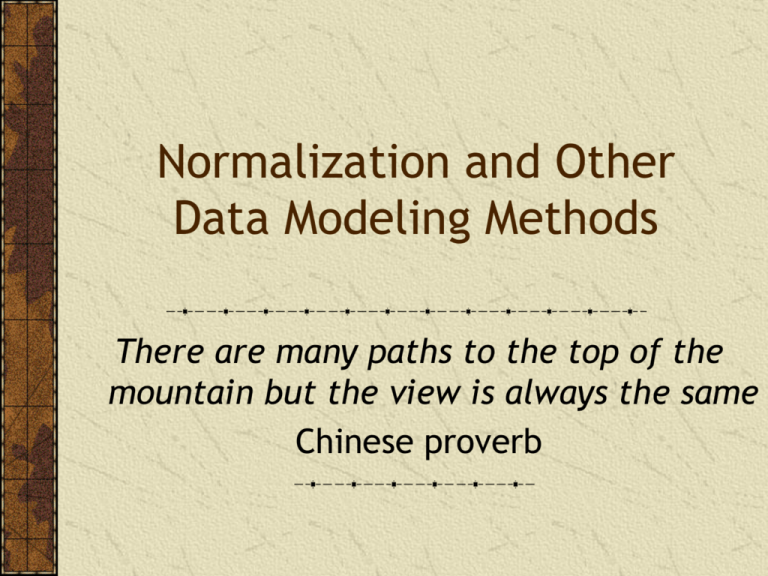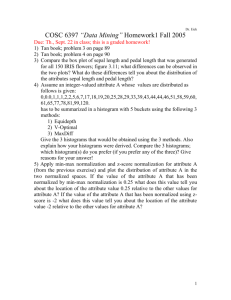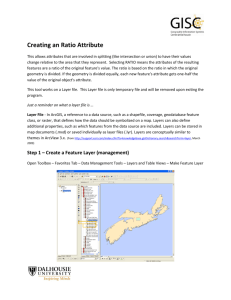Chapter 8 - Richard (Rick) Watson
advertisement

Normalization and Other Data Modeling Methods There are many paths to the top of the mountain but the view is always the same Chinese proverb Normalization An alternative database design tool to data modeling A theoretical foundation for the relational model Application of a series of rules that gradually improve the design Functional dependency A relationship between attributes in an entity One or more attributes determine the value of another attribute An identifier functionally determines all the attributes of an entity stock code firm name, stock price, stock quantity, stock dividend If we know stock code we know the value of firm name, etc. Multivalued dependency Formulae • (stock dividend, stock price) yield Full functional dependency Yield is fully functionally dependent on stock dividend and stock price because both of these attributes are required to determine the value of yield (stock dividend, stock price) yield Determinant An attribute that fully functionally determines another attribute • e.g., stock code determines stock PE Multidetermination A given value can determine multiple values A multidetermines B A B e.g., Department multidetermines course Multivalued dependency means functional dependencies are multivalued Attribute relationships One-to-one A value of an attribute determines the value of another attribute and vice versa A B and B A e.g., • CH Switzerland • Switzerland CH Attribute relationships One-to-many A value of one attribute determines the value of another attribute but not vice versa • country name currency unit • currency unit not country name Attribute relationships Many-to-many Neither attribute determines the other A not B B not A • country name not language • language not country name French and Flemish is spoken in Belgium French is spoken in many countries Normal forms A classification of relations Stacked like a set of Russian dolls Innermost is first normal form First normal form (1NF) All rows must have the same number of columns Single valued attributes only Second normal form (2NF) Violated when a nonkey column is a fact about part of the primary key A column is not fully functionally dependent on the primary key customer-credit in this case order itemno customerid quantity customer-credit 12 57 25 OK 34 679 3 POOR Third normal form (3NF) Violated when a nonkey column is a fact about another nonkey column A column is not fully functionally dependent on the primary key exchange rate in this case stock stock code nation exchange rate MG USA 0.67 IR AUS 0.46 Boyce-Codd normal form (BCNF) Arises when a table has multiple candidate keys the candidate keys are composite the candidate keys overlap advisor client probtype consultant Alpha Marketing Gomez Alpha Production Raginiski Fourth normal form (4NF) A row should not contain two or more multivalued independent facts student studentid sport subject … 50 Football English … 50 Football Music … 50 Tennis Botany … 50 Karate Botany … Fifth normal form (5NF) A table can be reconstructed from other tables There exists some rule that enables a relation to be inferred Base case Consultants provide skills to one or more firms and firms can use many consultants; a consultant has many skills and a skill can be used by many firms; and a firm can have a need for many skills and the same skill can be required by many firms Fifth normal form (5NF) The rule If a consultant has a certain skill (e.g., database) and has a contract with the firm that requires that skill (e.g., IBM), then the consultant advises the firm on that skill (i.e., he advises IBM on database) Domain key/ normal form (DK/NF) Key: unique identifier Constraint: rule governing attribute values Domain: set of values of the same data type Every constraint on the relation must be a logical consequence of the domain constraints and the key constraints that apply to the relation Data modeling and normalization Data modeling is often an easier path to good database design A high-fidelity data model will be of high normal form 5NF is likely to create the most problems Check for special rules Data modeling methods A widely known model is Chen's entityrelationship (E-R) approach There is no standard for the E-R method Nearly all data modeling approaches are very similar because they share common concepts Learning is readily transferable between methods An E-R diagram Representing relationships The various dialects are most distinctive in the ways in which relationships are represented Knowledge is very transferable between dialects Goal Learn to think like a data modeler Different dialects and greater precision (e.g., cardinality) come easily once the basics are mastered Key points Normalization is one approach to data modeling The are multiple representations for data model Learning to model is difficult Learning to represent a model is easy





